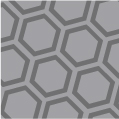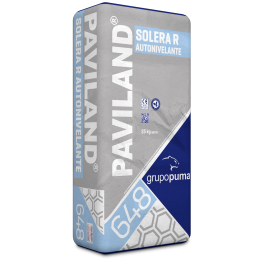 Paviland® Solera R Autonivelante
Paviland® Solera R Autonivelante

Self-levelling Mortar of great fluency, fast dry and once it gets hard, it create a slab of great flatness and mechanical resistance. Suitable for the accomplishment of self-levelling interiors from 5 to 50 mm in adhered screeds from 50 to 100 mm in floating screeds . Once hardened it must be covered by discontinuous pavements (ceramics, etc) or constant (paintings epoxy, etc). This self-levelling mortar has great levelling capacity, even in large thicknesses. Suitable for indoor floors. Radiant heating floors.
Additional information
Technical Caracteristics
Product-based cement, selected aggregates , synthetic resins and additives.
Advantages and Uses
- Large capacity levelling.
- Interior slabs: Adhered up to 50 mm and floating slabs for thicknesses between 50 and 100 mm.
- Suitable for slabs with radiant heating.
- Easy laying because of its high fluidity and flatness.
- Fast commissioning.
- Ideal for using in cold season, where normal self-levelling screeds need more time to put it into service.
Suitable Substrates
- Support should be resistant, stable, good conditions and clean, free of dust, remains gratty, organic products, etc.
- Before the application of PAVILAND SOLERA R AUTONIVELANTE, it has repaired adequately the hollows and / or fissures that they could find in the support by products of our range Niveland, Paviland or Morcem Rest, according to the nature of the support and repair to do.
- For adhered slabs (thicknesses lower than 50 mm) on resistant concrete supports, there will have to be applied before the PAVILAND PRIMER R. For other types of supports (ceramics, marble, etc), consult with our technical department.
- Floating Slabs for thicknesses of between 50 and 100 mm on insulating supports, plastic membranes or steam barriers. For other type of supports consult with our technical department.
Application Procedure
- Define and mark the maximum dimension of the screed.
- The pouring area must be established avoiding areas with different setting times, for this purpose the means available for carrying out the work, the environmental conditions and the open time of the mortar must be considered. Confining spillage areas beforehand can also be used for making partition joints, avoiding their subsequent execution by cutting.
- Knead with water (3, 75-4, 25 L per 25 Kg sack) mechanically, with a low speed (approx. 500 rpm) mechanical mixer until the dough gets smooth and without lumps. The exact dosage of water is very important to avoid segregation of product, high shrinkage and reduction of resistances.
- Let the dough about 2 minutes rest.
- For the accomplishment of big surfaces the pumping of the mixture is recommended with spiral bombs of double kneaded and that stimulate from 20 to 40 L/minute.
- This operation allows the optimization of the times of implantation.
- Extend manually with a metallic trowel grader as soon as the priming has hardened. Later, use a roller of prongs of nylon.
- Respect the structural joints and complete the perimeter and the partition joints•
- The self-levelling screed Paviland R must be protected by ceramic, resin, wood, linoleum, etc.
Recommendations
- Do not apply below 5 ° C or above 30 ° C.
- Do not apply with risk of frost, strong winds or direct sunlight.
- Not apply to outdoor.
- Do not apply to floors with humidity or with risk of having it.
- Keep in mind the working time of the product for the planning of the work.
- Wear gloves and safety glasses for use. Keep out of the reach of children.
- Do not add sand, cement or any type of product that modifies the original formulation.
- Once the product kneaded and its rest time has elapsed, do not add any extra water.
- For paves with superior surfaces to 20 M2 or more than 10 linear M, the accomplishment of partitions joints is recommended, delimiting slabs, with joints of approximately 6 mm that will be refilled by PUMALASTIC MS or PU.
- Movement joints will have to be respected of the original support and complete perimeter joints.
- The surface layer has to be protected from too fast drying , especially in conditions of high temperature or strong wind.
- Before laying the final pavement the residual dampness of the pave, must be verified and arranged according to the type of pavement to lay.
Packaging and Storage
Technical data
(Statistical results obtained under standard conditions)
| Appearance | Gray powder |
| Open time | 30 min |
| Consistency | 300±50 |
| Opening time pedestrian traffic (*) | 6 hours |
| Coating time for 3 cm thickness | Ceramic: 24 hours |
| Parquet or synthetic coating: 3 days | |
| Sanding time (*) | 24 hours |
| Resistance to compression | 10 n/mm2 (24 h) |
| 20 n/mm2 (7 d) | |
| 25 n/mm2 (28 d) | |
| Resistance to traction | ≥1.5N/mm2 |
| Approximate performance | 18 - 20 kg/m2 and cm thick |
| Classification according to UNE EN 13813 | CT C25 F5 B1, 5 |
| Thickness Application | 5 a 50 mm attached screeds |
| 50 100 mm floating screeds |
(*): The times refer to a temperature of 23ºC and 55% relative humidity. They are shorter at higher temperatures and longer at lower temperatures
CE Mark
|
GRUPO PUMA SL |
|
| EN 13813 PAVILAND SOLERA R AUTONIVELANTE Quick-setting cement self-levelling paste, type CT-C25-F5, for interior floors bonded up to 50 mm and unbonded up to 100 mm. |
|
| Reaction to fire | Class A1 |
| Emission of corrosive substances | CT |
| Resistance to compression | C25 |
| Resistance to bending | F5 |
Environmental Product Declaration (EPD)
Cement based mortar prepared with aggregates that are supplied close to the production center, which reduces the greenhouse gas emissions that would otherwise arise from their transport. Manufactured in production centers with an Environmental management certified system following ISO 14001 regulation, offering a firm promise of sustainability and respect for the environment. Cement based mortar with type III ecological label (the most strict) Environmental Product Declaration verified externally by AENOR.
Legal Disclaimer
GRUPO PUMA is not responsible, in any case, for the application of its products or constructive solutions carried out by the application company or other parties involved in the process and / or execution of the work, limiting the responsibility of GRUPO PUMA exclusively to the damages directly attributable to the supplied products, individually or integrated in systems, due to failures in their manufacturing process.
In any case, the drafter of the work project, the technical management or the person responsible for the work, or collaterally the application company or other parties involved in the process and / or execution of the work, must ensure the suitability of the products addressing the characteristics of them, as well as the conditions, support and possible pathologies of the work in question.
The values obtained by GRUPO PUMAS's products or its constructive solutions that, as the case may be, are determined by the EN standards or any other regulation that applies to it in each case refers exclusively to the conditions specifically stipulated in said regulation and that are referred to, among others, to certain characteristics of the support, humidity and temperature conditions, etc. without being them required in the tests obtained under different conditions, all in accordance with the relevant regulation.